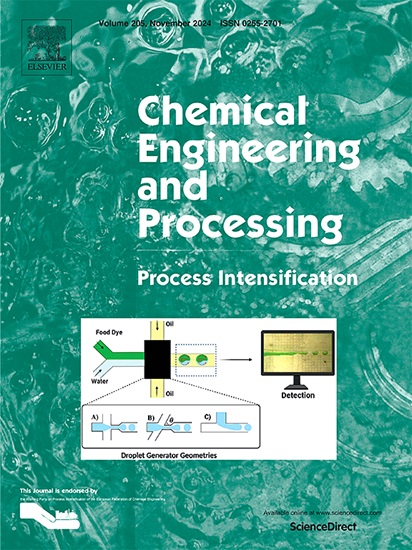Lithium extraction from lepidolite using molten ammonium bifluoride: applying response surface methodology to model and optimize the thermal process
IF 3.8
3区 工程技术
Q3 ENERGY & FUELS
Chemical Engineering and Processing - Process Intensification
Pub Date : 2025-04-29
DOI:10.1016/j.cep.2025.110336
引用次数: 0
Abstract
This work presents the modeling and optimization of a new lithium extraction method from lepidolite with molten NH4HF2. The interaction between the mineral and the fluorinating agent was studied by DSC, indicating that the reaction occurs between 75 and 160 °C, approximately. Thus, the temperature (), time (), and NH4HF2 amount () of the thermal process were studied by design of experiments (DOE) and response surface methodology (RSM). The DOE experimental results were modeled using least squares to obtain a predictive model of the system (R² = 0.9730). The ANOVA of the reduced cubic model indicated the influence of the three operating parameters investigated, and the interactions , , , and were significant. Finally, the process was optimized, obtaining Li extractions of 95 ± 4 % at 144 °C, 60 min of reaction, and using 13.5 g of NH4HF2 per gram of lepidolite. In this way, the new process minimizes operating conditions and costs and maximizes lithium extraction compared to traditional methods. Furthermore, this process allowed us to show the benefits and details of the correct application of DOE and RSM in extractive metallurgy processes.

熔融二氟化铵从锂云母中提取锂:应用响应面法模拟和优化热过程
本文介绍了一种用熔融NH4HF2从锂云母中提取锂的新方法的建模和优化。DSC研究了矿物与氟化剂之间的相互作用,表明反应发生在约75 ~ 160℃之间。因此,通过实验设计(DOE)和响应面法(RSM)研究了热过程的温度(T)、时间(T)和NH4HF2量(m)。对DOE实验结果进行最小二乘建模,得到系统的预测模型(R²= 0.9730)。简化三次模型的方差分析表明,所研究的三个操作参数的影响,相互作用的Tm, T2, m2和T2m是显著的。最后对工艺进行优化,在144℃,反应60 min,每克锂云母中NH4HF2用量为13.5 g的条件下,锂的提取率为95±4%。通过这种方式,与传统方法相比,新工艺最大限度地减少了操作条件和成本,并最大限度地提高了锂提取。此外,该过程使我们能够展示DOE和RSM在萃取冶金过程中正确应用的好处和细节。
本文章由计算机程序翻译,如有差异,请以英文原文为准。
求助全文
约1分钟内获得全文
求助全文
来源期刊
CiteScore
7.80
自引率
9.30%
发文量
408
审稿时长
49 days
期刊介绍:
Chemical Engineering and Processing: Process Intensification is intended for practicing researchers in industry and academia, working in the field of Process Engineering and related to the subject of Process Intensification.Articles published in the Journal demonstrate how novel discoveries, developments and theories in the field of Process Engineering and in particular Process Intensification may be used for analysis and design of innovative equipment and processing methods with substantially improved sustainability, efficiency and environmental performance.

 求助内容:
求助内容: 应助结果提醒方式:
应助结果提醒方式:


